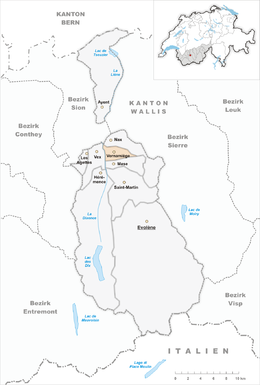Vernamiège
| Vernamiège | ||
|---|---|---|
| Former municipality of Switzerland | ||
|
||
| Coordinates: 46°13′N 7°26′E / 46.217°N 7.433°ECoordinates: 46°13′N 7°26′E / 46.217°N 7.433°E | ||
| Country | Switzerland | |
| Canton | Valais | |
| District | Hérens | |
| Area | ||
| • Total | 7.4 km2 (2.9 sq mi) | |
| Elevation | 1,321 m (4,334 ft) | |
| Population | ||
| • Total | 153 | |
| • Density | 21/km2 (54/sq mi) | |
| Postal code | 1961 | |
| SFOS number | 6088 | |
| Surrounded by | Mase, Nax, Sion, Vex | |
| Website |
www SFSO statistics |
|
Vernamiège is a former municipality in the district of Hérens in the canton of Valais in Switzerland. On 1 January 2011, the former municipalities of Vernamiège, Nax and Mase merged in the new municipality of Mont-Noble.
Vernamiège has an area, as of 2009[update], of 7.4 square kilometers (2.9 sq mi). Of this area, 1.51 km2 (0.58 sq mi) or 20.4% is used for agricultural purposes, while 5.28 km2 (2.04 sq mi) or 71.4% is forested. Of the rest of the land, 0.3 km2 (0.12 sq mi) or 4.1% is settled (buildings or roads), 0.02 km2 (4.9 acres) or 0.3% is either rivers or lakes and 0.28 km2 (0.11 sq mi) or 3.8% is unproductive land.
Of the built up area, housing and buildings made up 1.6% and transportation infrastructure made up 2.3%. Out of the forested land, 65.9% of the total land area is heavily forested and 5.5% is covered with orchards or small clusters of trees. Of the agricultural land, 0.0% is used for growing crops and 8.7% is pastures, while 1.2% is used for orchards or vine crops and 10.6% is used for alpine pastures. All the water in the village is flowing water. Of the unproductive areas, 1.5% is unproductive vegetation and 2.3% is too rocky for vegetation.
The blazon of the village coat of arms is Azure a Crosier Or issuant from base and an alder-tree Branch Vert fructed Sable in saltire in chief two Mullets of Five of the second.
Vernamiège has a population (as of December 2002[update]) of 153.
Most of the population (as of 2000[update]) speaks French (132 or 91.7%) as their first language, German is the second most common (11 or 7.6%) and Dutch is the third (1 or 0.7%).
...
Wikipedia




